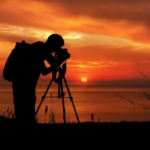As photographers, we’re always on the lookout for that perfect shot – the one that stops people in their tracks and makes them go “wow.” And what’s more breathtaking than capturing the majesty of a sunrise or sunset? The golden hour, when the sun rises or sets, is a photographer’s paradise. The soft, warm light casts a magical glow on the landscape, making it the perfect time to snap some stunning shots. But, capturing stunning sunrises and sunsets requires more than just showing up at the right time. It takes planning, patience, and a few tricks up your sleeve. In this article, we’ll share some valuable tips to help you capture the breathtaking beauty of sunrises and sunsets.
Tip 1: Timing is Everything
Before we dive into the nitty-gritty of photography, it’s essential to understand the importance of timing. Sunrises and sunsets are fleeting moments, and you need to be prepared to capture them. Plan your shoot around the time of sunrise or sunset, taking into account the location’s time zone and the time of year. For example, during the summer months, the sun rises around 5:30 am and sets around 8:30 pm, while in the winter, it rises around 7:30 am and sets around 4:30 pm. Be sure to check the weather forecast and plan accordingly. A clear sky will make your shot even more stunning, so try to avoid shooting during overcast or rainy days.
Tip 2: Choose the Right Location
The location is crucial when capturing stunning sunrises and sunsets. Look for spots with an unobstructed view of the horizon, such as beaches, mountains, or deserts. Avoid areas with tall buildings or trees that might block your shot. Consider locations with unique features like rock formations, waterfalls, or interesting textures that can add depth to your image. Some popular locations for sunrise and sunset photography include:
- Beaches: With the ocean as a backdrop, beaches offer a serene and peaceful atmosphere, perfect for capturing stunning sunrises and sunsets.
- Mountains: Mountain ranges provide a dramatic backdrop for your shot, with the sun rising or setting behind the peaks.
- Deserts: The vast, open spaces of the desert make it an ideal location for capturing the majesty of the sun rising or setting.
Tip 3: Use the Right Equipment
When it comes to capturing stunning sunrises and sunsets, the right equipment can make all the difference. Here are a few essentials to consider:
- Camera: A DSLR or mirrorless camera is ideal for capturing high-quality images. Look for a camera with good low-light performance and a wide dynamic range.
- Lens: A wide-angle lens (between 10-24mm) is perfect for capturing the vastness of the landscape. A telephoto lens (between 70-200mm) can help compress the scene and create a sense of depth.
- Tripod: A sturdy tripod will help you stabilize your camera, allowing you to take sharper images and avoid camera shake.
- Filters: A polarizing filter can help reduce glare and enhance the colors of the scene. A neutral density filter can help balance the exposure and create a more balanced image.
Tip 4: Shoot in RAW
When capturing stunning sunrises and sunsets, it’s essential to shoot in RAW format. RAW files contain more data than JPEGs, giving you more flexibility when editing your images. This is particularly important when capturing high-contrast scenes, as RAW files can help you recover more detail in the shadows and highlights.
Tip 5: Experiment with Composition
Composition is key when capturing stunning sunrises and sunsets. Experiment with different angles and compositions to add visual interest to your shot. Consider using leading lines, framing, or symmetry to create a more dynamic image. Don’t be afraid to get creative and try new things – it’s all part of the fun!
Tip 6: Pay Attention to Lighting
Lighting is the lifeblood of photography, and sunrises and sunsets are no exception. Pay attention to the direction and quality of light. Soft, warm light can create a sense of warmth and coziness, while harsh, direct light can add drama and contrast to your image. Experiment with different lighting conditions to find the one that works best for your shot.
Tip 7: Shoot in Bracketed Exposures
When capturing high-contrast scenes, it’s essential to shoot in bracketed exposures. This will allow you to capture a range of exposures, which you can later merge using HDR software. This technique can help you capture more detail in the shadows and highlights, resulting in a more balanced image.
Tip 8: Edit Your Images
Finally, don’t forget to edit your images! Editing is an essential part of the photography process, and it can make a huge difference in the final result. Use software like Lightroom or Photoshop to adjust the exposure, contrast, and colors of your image. Pay attention to the histogram and adjust the levels accordingly. Don’t be afraid to experiment and try new things – it’s all part of the creative process!
In conclusion, capturing stunning sunrises and sunsets requires more than just showing up at the right time. It takes planning, patience, and a few tricks up your sleeve. By following these tips, you’ll be well on your way to capturing breathtaking images that will leave people in awe. Remember to plan your shoot around the time of sunrise or sunset, choose the right location, and use the right equipment. Experiment with composition, pay attention to lighting, and shoot in bracketed exposures. Finally, don’t forget to edit your images and have fun!










